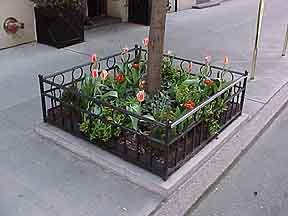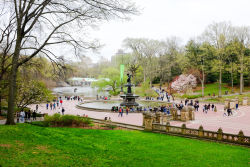Central Park
The Daily Plant : Tuesday, August 7, 2001
TREE PIT GUARDS PROTECT NEW YORK CITY’S TREES

One fifth of the trees on New York City's public land are street trees. Street trees provide cooling shade, cleaner air, and more beautiful urban streetscapes. Unfortunately our congested city streets can be hazardous for our trees. Cars, bikes, dogs, toxins, and a harsh environment all threaten tree health and longevity. When designed appropriately, tree pit guards can help mitigate these hazards. A tree pit guard is usually a cast-iron fence or wrought-iron wickets installed around a tree pit for protection. Parks strongly encourages their installation, because tree pit guards:
Discourage dogs from defecating in tree pits.
Assist air and water penetration to the root zone by reducing paving
block installation.
Protect trees from mechanical damage caused by car doors, bumpers, and
other sources of street and sidewalk traffic.
Prevent bikes from being chained to trees.
Encourage flower planting by property owners, who in turn cultivate the
soil and water trees.
Reduce soil compaction by providing a barrier to foot traffic over the
root zone.
Recent changes to Department of Transportation guidelines allow for tree guards. Tree guards are installed by property owners, businesses, neighborhood block associations, and business improvement districts. No permits are necessary, but Parks will take action if the tree guards endanger the long-term health and survival of city-owned trees. Citizens can follow these guidelines to protect their trees:
DO install a low cast-iron fence (or wrought-iron wickets) approximately 18" high, around the perimeter of the tree pit. This will protect the tree from dogs and pedestrians, and leave enough space for it to grow into a healthy tree.
DON'T install tall, close-fitting tree guards. They strangle the tree as it grows, fail to protect the root zone, and impede tree maintenance.
DON'T install sidewalk-level tree grates. They do not protect the tree trunk, and while they look attractive for the first few years, the tree will grow into them and die if the openings are not periodically widened. They also serve as receptacles for street litter, and if raised by the tree's growth will cause a trip hazard.
DON'T install brick or concrete tree wells. The interior space created by the solid wall encourages property owners to add soil over the root zone for plantings, unwittingly suffocating tree roots. Walls also impede drainage.
In Uptown Manhattan tree pit guards are being installed for existing trees in the Columbus/Amsterdam BID with funds from Manhattan Borough President C. Virginia (Sparrow) Fields. Parks and the New York Tree Trust now administer a tree rescue program in which a contractor unshackles trees strangled by tree guards. Any tree protection device that is endangering the health of a city tree should be reported to 1-800-201-PARK, or to the borough forestry office. To learn more about caring for trees in your neighborhood, you can become a Citizen Pruner. Call Trees New York at (212) 227-1887 to get information about the twelve-hour training program.
By Douglas (Slugfest) Still and Fiona (Treetop) Watt
THIRTEEN YEARS AGO IN THE PLANT
(Tuesday, August 9, 1988)
MAYOR KOCH OPENS CENTRAL PARK ZOO
The Central Park Zoo, at 5.5 acres one of the smallest and finest municipal zoos in the world, has held a much larger place in the hearts of New Yorkers than its size would indicate. So the joyous outpouring of about 14,000 New Yorkers at yesterday's official opening of the newly reconstructed zoo was no surprise.
"This is a new kind of zoo," Mayor Koch told the thousands of visitors ringing the sea lion pool, referring to the new zoo design which places strong emphasis on recreating the natural habitats of the zoo's 450 animals. We can be proud of the Central Park Zoo. It was constructed basically on time and within budget. Take care of this zoo like it is yours." the Mayor added, "Because it is." Then, after cutting a garland of flowers to officially open the zoo, the Mayor fed Fin the sea lion a mackerel after the animal waved his fin and barked at command.
QUOTATION FOR THE DAY
"A brotherhood of venerable trees."
William Wordsworth (1770-1850)
Check out your park's Vital Signs
Clean & Safe
Green & Resilient
Empowered & Engaged Users
Share your feedback or learn more about how this park is part of a
Vital Park System

Know Before You Go
Anticipated Completion: Spring 2024
Anticipated Completion: Spring 2025

Contacts
Central Park Information: (212) 310-6600
Central Park Information (for the Hearing Impaired): (800) 281-5722
Belvedere Castle, The Henry Luce Nature Observatory: (212) 772-0210
The Charles A. Dana Discovery Center: (212) 860-1370
The Dairy Visitor Center and Gift Shop: (212) 794-6564
North Meadow Recreation Center: (212) 348-4867
Loeb Boathouse (Bike rentals, boat rentals & gondolas): (212) 517-2233
Carousel: (212) 879-0244
Fishing at Harlem Meer (Catch & Release): (212) 860-1370
Harlem Meer Performance Festival: (212) 860-1370
Horseback Riding - Claremont Stables: (212) 724-5100
Metropolitan Opera (Performances on the Great Lawn): (212) 362-6000
New York Philharmonic (Performances on the Great Lawn): (212) 875-5709
Shakespeare in the Park - The Public Theater at the Delacorte Theater: (212) 539-8655
Central Park SummerStage: (212) 360-2777
Swedish Cottage Marionette Theater: (212) 988-9093
Tennis: (212) 280-0205
Weddings, Ceremonies and Photography at the Conservatory Garden: (212) 360-2766
Wildlife Center & Tisch Children's Zoo: (212) 439-6500











